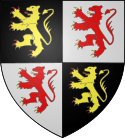Duke of Brabant
The Duke of Brabant was formally the ruler of the Duchy of Brabant since 1183/1184. The title was created by the German Emperor Frederick Barbarossa in favor of Henry I of the House of Reginar, son of Godfrey III of Leuven (who was Duke of Lower Lotharingia at that time). The Duchy of Brabant was a feudal elevation of the since 1085/1086 existing title of Landgrave of Brabant. This was an Imperial fief which was assigned to Count Henry III of Leuven shortly after the death of the preceding Count of Brabant, Count Palatine Herman II of Lotharingia (born 20 September 1085). Although the corresponding county was quite small (limited to the territory between the rivers Senne and Dender) its name was applied to the entire country under control of the Dukes from the 13th century on. In 1190, after the death of Godfrey III, Henry I also became Duke of Lotharingia. Formerly Lower Lotharingia, this title was now practically without territorial authority, but was borne by the later Dukes of Brabant as an honorific title.
In 1288, the Dukes of Brabant became also Duke of Limburg. The title fell to the Dukes of Burgundy in 1430. Later on, it followed with the Burgundian inheritance until the French Revolution, although the northern part of the territory of Brabant was actually governed by the United Provinces during the 17th and 18th century (see Generality Lands).
House of Reginar (House of Leuven)


.svg.png)
Counts of Leuven, Counts of Brussels and Landgraves of Brabant:
- Henry III (1085/1086–1095); already Count of Leuven and Brussels from 1078.
- Godfrey I (from 1095)
Counts of Leuven, Counts of Brussels, Landgraves of Brabant, Margrave of Antwerp and Dukes of Lower-Lorraine:
- Godfrey I (1106–1139) appointed as Duke in 1106
- Godfrey II (1139–1142)
- Godfrey III (1142–1190)
Dukes of Brabant and Dukes of Lothier:
- Henry I (1190–1235); already Duke of Brabant from 1183/1184
- Henry II (1235–1248)
- Henry III (1248–1261)
- Henry IV (1261–1267)
Dukes of Brabant, Dukes of Lothier and Dukes of Limburg:
House of Burgundy
Dukes of Brabant, Dukes of Lothier and Dukes of Limburg:
- Anthony, Duke of Brabant (1406–1415) (inherited title from his aunt, Joanna)
- John IV, Duke of Brabant (1415–1427)
- Philip I of Saint-Pol (1427–1430)
- Philip II the Good (1430–1467)
- Charles I the Bold (1467–1477)
- Mary (1477–1482)
House of Habsburg
- Maximilian (regent, 1482–1494)
- Philip III (1494–1506)
- Charles II (1506–1555)
- Philip IV (1555–1598)
- usurpation by Francis, Duke of Anjou (Valois) (1582–1584)[1]
- Isabella Clara Eugenia and Albert (1598-1621)
- Philip V (1621-1665)
- Charles III (1665-1700)
House of Bourbon
- Philip VI (1700-1706)
House of Habsburg
- Charles IV (1706-1740)
- Maria Theresa (1740-1780)
- Joseph (1780-1789)
- Leopold (1790-1792)
- Francis I (1792-1794)
Revived title in contemporary tradition
House of Saxe-Coburg and Gotha
In the modern Kingdom of Belgium, the title of "Duke of Brabant" revived as honorific title and is traditionally assigned to the Crown Prince (even though the province of Noord-Brabant, part of the historical duchy, is now part of the Netherlands and has been so since 1648).
- Leopold II (1840–1865)
- Leopold, son of Leopold II (1865–1869)
- Leopold III (1909–1934)
- Baudouin (1934–1951)
- Philippe (1993–2013)
- Elisabeth (2013–present)
In contrast to King Philippe's title, King of the Belgians, the crown princess, Princess Elisabeth is called a Princess of Belgium, not of the Belgians. She is also Duchess of Brabant, the traditional title of the heir apparent to the Belgian throne. As a dynastic title it takes precedence over the title Princess of Belgium.

Legislation
Article 1, alinea 2, of the Royal Decree of 16 December 1840 says, since an amendment in 2001 : « The title of Duke of Brabant or of Duchess of Brabant will be worn, in future, by the Prince or the Princess, elder son or daughter of the King, and, if lacking, by the Prince or the Princess, elder son or daughter of the elder son or daughter of the King » [2]
House of Bourbon
- Juan Carlos I, King of Spain
- Felipe VI, King of Spain
The title Duke of Brabant is one of the titles of the Spanish Crown,, which is occupied by a member of the House of Bourbon.
See also
References
- ↑ Knecht, Catherine de' Medici, Longman, 1998, p. 212.
- ↑ Text in French of the 2001 amendment : « Le titre de Duc de Brabant ou de Duchesse de Brabant sera toujours porté, à l'avenir, par le Prince ou la Princesse, fils aîné ou fille aînée du Roi, et, à défaut, par le Prince ou la Princesse, fils aîné ou fille aînée du fils aîné de la fille aînée du Roi. »
- Charters of the Duchy of Brabant
- Counts of Louvain: genealogical note (Caution: some information provided by this link could be historiographically obsolete).